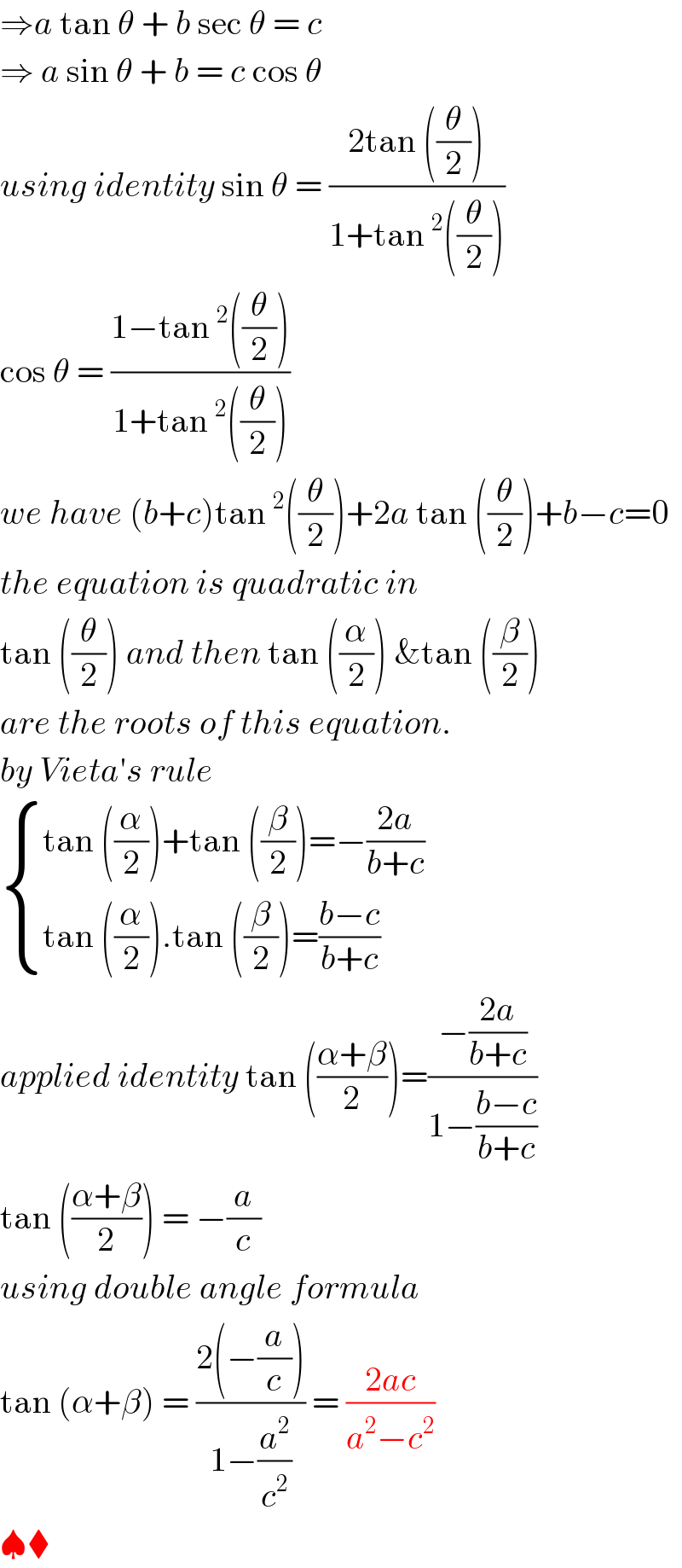
Question Number 105759 by bramlex last updated on 31/Jul/20

$${If}\:\alpha\:{and}\:\beta\:{are}\:{the}\:{solution}\:{of} \\ $$$${equation}\:{a}\:\mathrm{tan}\:\theta\:+\:{b}\:\mathrm{sec}\:\theta\:=\:{c}\:.\: \\ $$$${find}\:{the}\:{value}\:{of}\:\mathrm{tan}\:\left(\alpha+\beta\right). \\ $$
Commented by bramlex last updated on 31/Jul/20

$${thx}\:{both} \\ $$
Answered by john santu last updated on 31/Jul/20

$$\Rightarrow{a}\:\mathrm{tan}\:\theta\:+\:{b}\:\mathrm{sec}\:\theta\:=\:{c}\: \\ $$$$\Rightarrow\:{a}\:\mathrm{sin}\:\theta\:+\:{b}\:=\:{c}\:\mathrm{cos}\:\theta\: \\ $$$${using}\:{identity}\:\mathrm{sin}\:\theta\:=\:\frac{\mathrm{2tan}\:\left(\frac{\theta}{\mathrm{2}}\right)}{\mathrm{1}+\mathrm{tan}\:^{\mathrm{2}} \left(\frac{\theta}{\mathrm{2}}\right)} \\ $$$$\mathrm{cos}\:\theta\:=\:\frac{\mathrm{1}−\mathrm{tan}\:^{\mathrm{2}} \left(\frac{\theta}{\mathrm{2}}\right)}{\mathrm{1}+\mathrm{tan}\:^{\mathrm{2}} \left(\frac{\theta}{\mathrm{2}}\right)} \\ $$$${we}\:{have}\:\left({b}+{c}\right)\mathrm{tan}\:^{\mathrm{2}} \left(\frac{\theta}{\mathrm{2}}\right)+\mathrm{2}{a}\:\mathrm{tan}\:\left(\frac{\theta}{\mathrm{2}}\right)+{b}−{c}=\mathrm{0} \\ $$$${the}\:{equation}\:{is}\:{quadratic}\:{in}\: \\ $$$$\mathrm{tan}\:\left(\frac{\theta}{\mathrm{2}}\right)\:{and}\:{then}\:\mathrm{tan}\:\left(\frac{\alpha}{\mathrm{2}}\right)\:\&\mathrm{tan}\:\left(\frac{\beta}{\mathrm{2}}\right) \\ $$$${are}\:{the}\:{roots}\:{of}\:{this}\:{equation}. \\ $$$${by}\:{Vieta}'{s}\:{rule}\: \\ $$$$\begin{cases}{\mathrm{tan}\:\left(\frac{\alpha}{\mathrm{2}}\right)+\mathrm{tan}\:\left(\frac{\beta}{\mathrm{2}}\right)=−\frac{\mathrm{2}{a}}{{b}+{c}}}\\{\mathrm{tan}\:\left(\frac{\alpha}{\mathrm{2}}\right).\mathrm{tan}\:\left(\frac{\beta}{\mathrm{2}}\right)=\frac{{b}−{c}}{{b}+{c}}}\end{cases} \\ $$$${applied}\:{identity}\:\mathrm{tan}\:\left(\frac{\alpha+\beta}{\mathrm{2}}\right)=\frac{−\frac{\mathrm{2}{a}}{{b}+{c}}}{\mathrm{1}−\frac{{b}−{c}}{{b}+{c}}} \\ $$$$\mathrm{tan}\:\left(\frac{\alpha+\beta}{\mathrm{2}}\right)\:=\:−\frac{{a}}{{c}} \\ $$$${using}\:{double}\:{angle}\:{formula} \\ $$$$\mathrm{tan}\:\left(\alpha+\beta\right)\:=\:\frac{\mathrm{2}\left(−\frac{{a}}{{c}}\right)}{\mathrm{1}−\frac{{a}^{\mathrm{2}} }{{c}^{\mathrm{2}} }}\:=\:\frac{\mathrm{2}{ac}}{{a}^{\mathrm{2}} −{c}^{\mathrm{2}} } \\ $$$$\spadesuit\blacklozenge \\ $$
Commented by Coronavirus last updated on 01/Aug/20
clear thanks you sir
Answered by bobhans last updated on 31/Jul/20

$${a}\:\mathrm{tan}\:\theta\:+\:{b}\:\mathrm{sec}\:\theta\:=\:{c}\: \\ $$$$\rightarrow{a}\:\mathrm{tan}\:\theta−{c}\:=\:−{b}\:\mathrm{sec}\:\theta \\ $$$${squaring}\:{both}\:{side}\: \\ $$$$\left({a}\:\mathrm{tan}\:\theta−{c}\right)^{\mathrm{2}} \:=\:{b}^{\mathrm{2}} \left(\mathrm{1}+\mathrm{tan}\:^{\mathrm{2}} \theta\right) \\ $$$$\left({a}^{\mathrm{2}} −{b}^{\mathrm{2}} \right)\mathrm{tan}\:^{\mathrm{2}} \theta\:−\mathrm{2}{ac}\:\mathrm{tan}\:\theta\:+\:{c}^{\mathrm{2}} −{b}^{\mathrm{2}} =\mathrm{0}\: \\ $$$${has}\:{the}\:{roots}\:{are}\:\mathrm{tan}\:\alpha\:{and}\:\mathrm{tan}\:\beta \\ $$$${Vieta}'{s}\:{rule}\:\begin{cases}{\mathrm{tan}\:\alpha+\mathrm{tan}\:\beta=\frac{\mathrm{2}{ac}}{{a}^{\mathrm{2}} −{b}^{\mathrm{2}} }}\\{\mathrm{tan}\:\alpha.\mathrm{tan}\:\beta\:=\:\frac{{c}^{\mathrm{2}} −{b}^{\mathrm{2}} }{{a}^{\mathrm{2}} −{b}^{\mathrm{2}} }}\end{cases} \\ $$$${therefore}\:\mathrm{tan}\:\left(\alpha+\beta\right)\:=\:\frac{\mathrm{tan}\:\alpha+\mathrm{tan}\:\beta}{\mathrm{1}−\mathrm{tan}\:\alpha.\mathrm{tan}\:\beta} \\ $$$$\:=\:\frac{\mathrm{2}{ac}}{{a}^{\mathrm{2}} −{c}^{\mathrm{2}} }\:\bigstar \\ $$
Commented by Coronavirus last updated on 01/Aug/20
wouah very fast method
